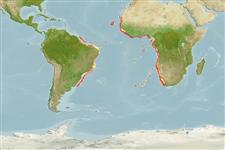Common names from other countries
Environment: milieu / climate zone / depth range / distribution range
Écologie
; profondeur 160 - 1013 m (Ref. 104052), usually 400 - 500 m (Ref. 104052). Tropical; 22°N - 35°S, 76°W - 18°E (Ref. 104052)
Distribution
Pays | Zones FAO | Écosystèmes | Occurrences | Introductions
Atlantic Ocean: Mauritania to Namibia, St. Helena, and off the coast of Brazil. Tropical to subtropical.
Length at first maturity / Taille / Poids / Âge
Maturity: Lm ? range ? - ? cm Max length : 14.0 cm CL mâle / non sexé; (Ref. 104052)
Deep water species living on the upper continental slope. Juveniles occur in deeper waters than adults (Ref. 8826). Found on muddy bottoms (Ref. 104052).
Life cycle and mating behavior
Maturité | Reproduction | Frai | Œufs | Fécondité | Larves
Members of the order Decapoda are mostly gonochoric. Mating behavior: Precopulatory courtship ritual is common (through olfactory and tactile cues); usually indirect sperm transfer.
SAUP Database. 2006. (Ref. 356)
Statut dans la liste rouge de l'IUCN (Ref. 130435)
statut CITES (Ref. 108899)
Not Evaluated
Not Evaluated
Utilisations par l'homme
Pêcheries: commercial
| FishSource | Sea Around Us
Outils
Plus d'informations
Taille/ÂgeCroissanceLongueur-poidsLongueur-longueurMorphologieLarvesAbondance
Sources Internet
Estimates based on models
Vulnérabilité
Low vulnerability (10 of 100).
Catégorie de prix
Unknown.
